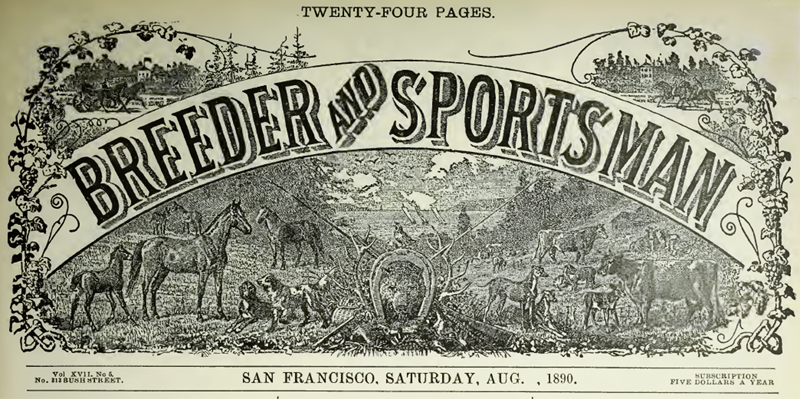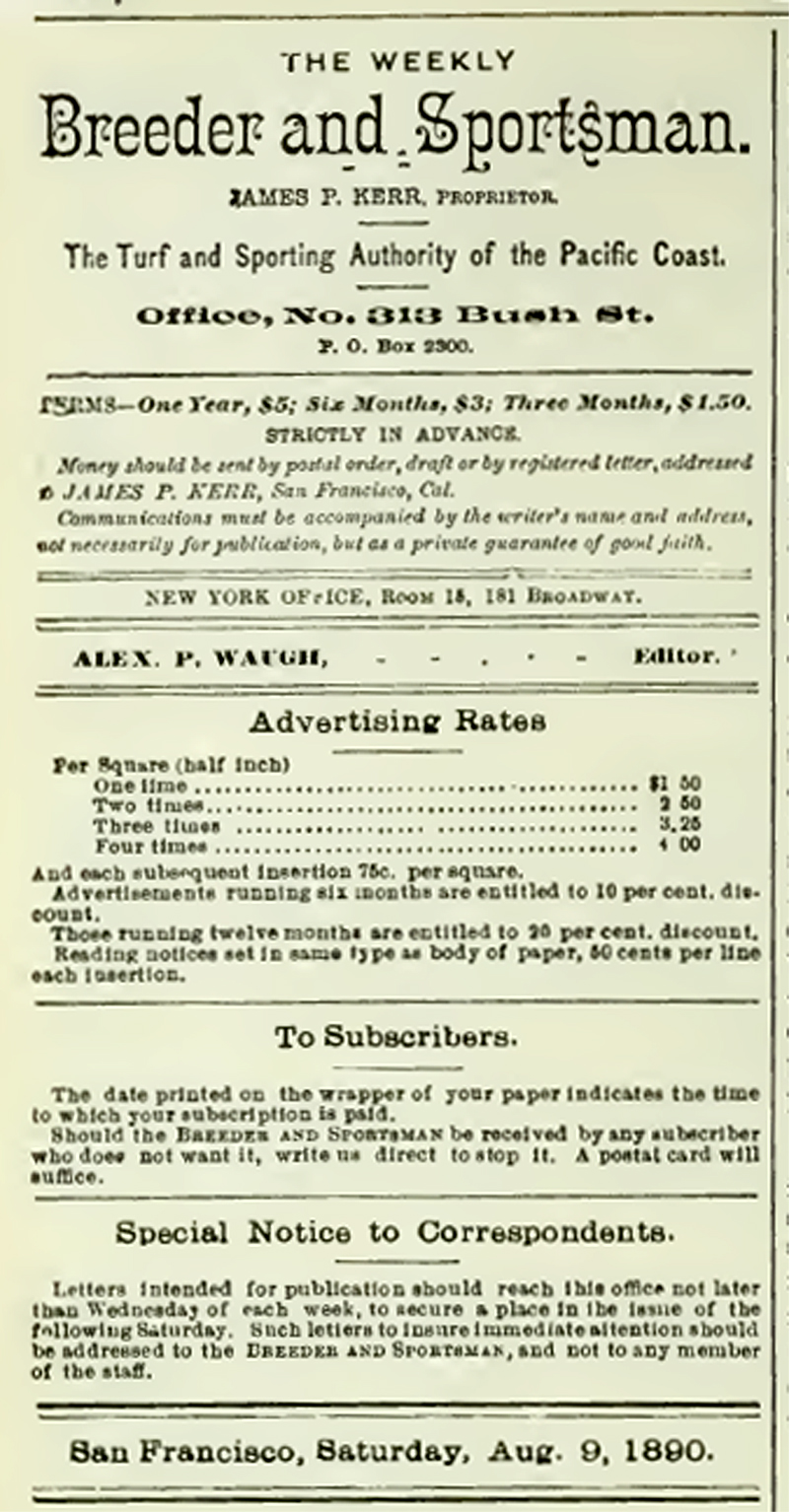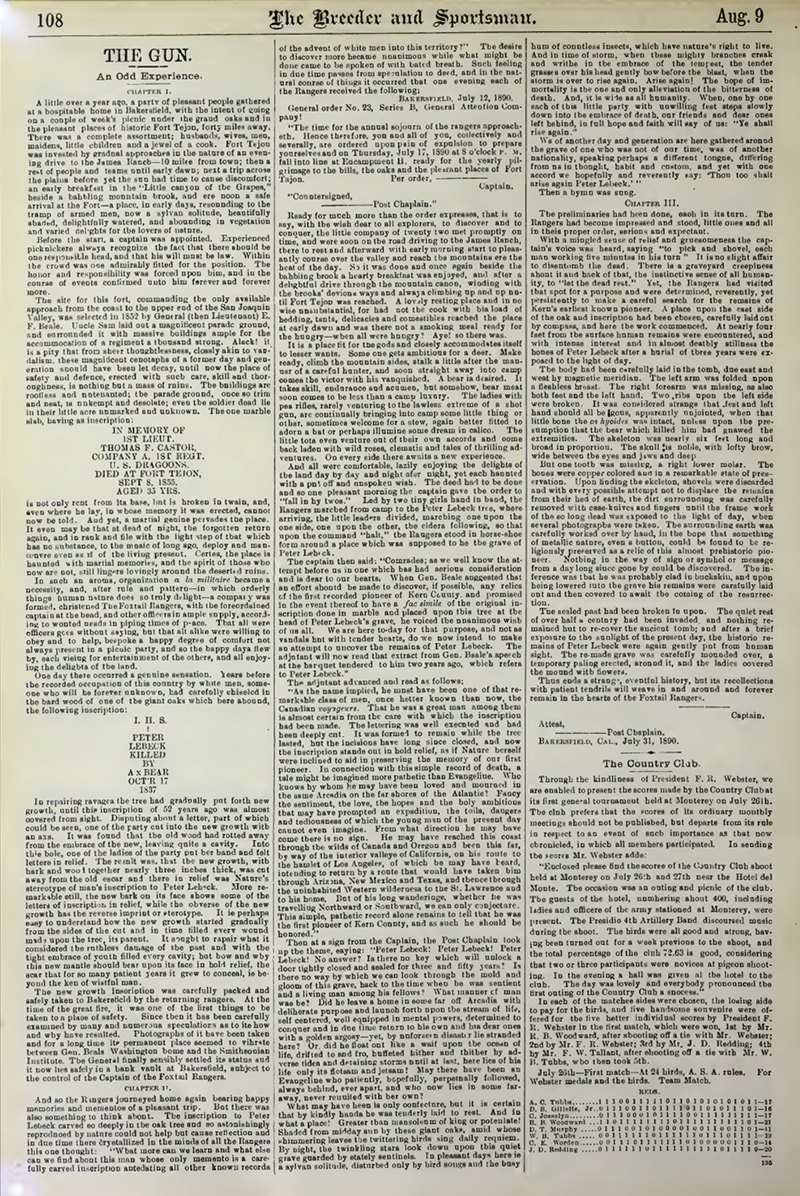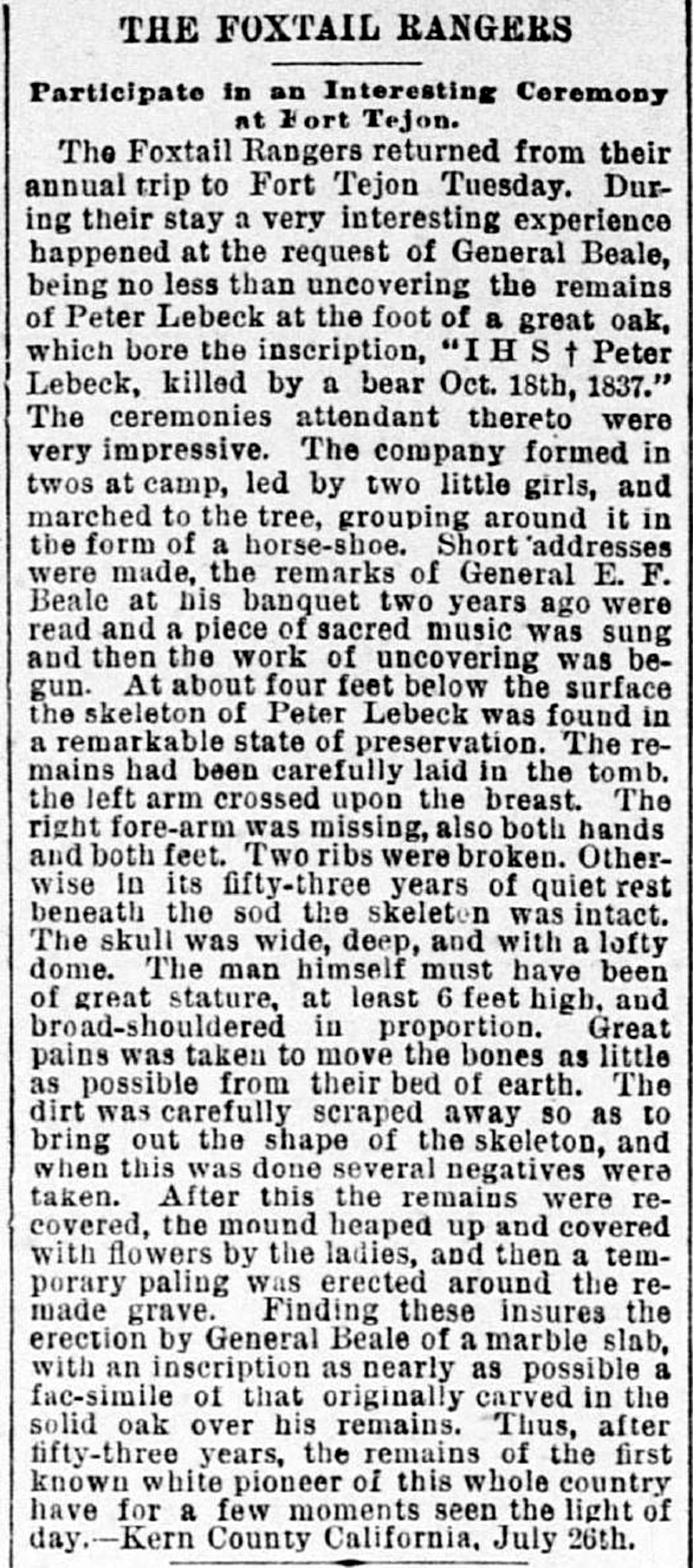|
|
Foxtail Rangers Exhume and Rebury Peter Lebeck.
The Weekly Breeder and Sportsman | Alex P. Waugh, Editor.
San Francisco, Saturday, August 9, 1890.
|
CHAPTER I. A little over a year ago, a party of pleasant people gathered at a hospitable home in Bakersfield, with the intent of going on a couple of week's picnic under the grand oaks and in the pleasant places of historic Fort Tejon, forty miles away. There was a complete assortment; husbands, wives, men, maidens, little children and a jewel of a cook. Fort Tejon was invested by gradual approaches in the nature of an evening drive to the James Ranch — 10 miles from town; then a rest of people and teams until early dawn; next a trip across the plains before yet the sun had time to cause discomfort; an early breakfast in the "Little canyon of the Grapes," beside a babbling mountain brook, and ere noon a safe arrival at the Fort — a place, in early days, resounding to the tramp of armed men, now a sylvan solitude, beautifully shaded, delightfully watered, and abounding in vegetation and varied delights for the lovers of nature. Before the start, a captain was appointed. Experienced picknickers always recognize the fact that there should be one responsible head, and that his will must be law. Within the crowd was one admirably fitted for the position. The honor and responsibility was forced upon him, and in the course of events confirmed unto him forever and forever more. The site for this fort, commanding the only available approach from the coast to the upper end of the San Joaquin Valley, was selected in 1852 by General (then Lieutenant) E.F. Beale. Uncle Sam laid out a magnificent parade ground, and surrounded it with massive buildings ample for the accommodation of a regiment a thousand strong. Alack! it is a pity that from sheer thoughtlessness, closely akin to vandalism, these magnificent cenotaphs of a former day and generation should have been let decay, until now the place of safety and defense, erected with such care, skill and thoroughness, is nothing but a mass of ruins. The buildings are rootless and untenanted; the parade ground, once so trim and neat, is unkempt and desolate; even the soldier dead lie in their little acre unmarked and unknown. The one marble slab, having as inscription:
IN MEMORY OF is not only rent from its base, but is broken in twain, and, even where he lay, in whose memory it was erected, cannot now be told. And yet, a martial genius pervades the place. It even may be that at dead of night, the forgotten return again, and in rank and file with the light step of that which has no substance, to the music of long ago, deploy and manoeuvre even as if of the living present. Certes, the place is haunted with martial memories, and the spirit of those who now are not, still lingers lovingly around the deserted ruins. In such an aroma, organization a la militaire became a necessity, and, after rule and pattern — in which orderly things human nature does so truly delight — a company was formed, christened The Foxtail Rangers, with the foreordained captain at the head, and other officers in ample supply, according to wonted needs in piping times of peace. That all were officers goes without saying, but that all alike were willing to obey and to help, bespoke a happy degree of comfort not always present in a picnic party, and so the happy days flew by, each vieing for entertainment of the others, and all enjoying the delights of the land. One day there occurred a genuine sensation. Years before the recorded occupation of this country by white men, someone who will be forever unknown, had carefully chiseled in the bard wood of one of the giant oaks which here abound, the following inscription:
I.H.S. In repairing ravages the tree had gradually put forth new growth, until this inscription of 52 years ago was almost covered from sight. Disputing about a letter, part of which could be seen, one of the party cut into the new growth with an axe. It was found that the old wood had rotted away from the embrace of the new, leaving quite a cavity. Into this hole, one of the ladies of the party put her hand and felt letters in relief. The result was that the new growth, with bark and wood together nearly three inches thick, was cut away from the old escar [sic; eschar] and there in relief was Nature's stereotype of man's inscription to Peter Lebeck. More remarkable still, the new bark on its face shows some of the letters of inscription in relief, while the obverse of the new growth has the reverse imprint or ster[e]otype. It is perhaps easy to understand how the new growth started gradually from the sides of the cut and in time filled every wound made upon the tree, its parent. It sought to repair what it considered the ruthless damage of the past and with the tight embrace of youth filled every cavity; but how and why this new mantle should bear upon its face in bold relief, the scar that for so many patient years it grew to conceal, is beyond the ken of wistful man. The new growth inscription was carefully packed and safely taken to Bakersfield by the returning rangers. At the time of the great fire, it was one of the first things to be taken to a place of safety. Since then it has been carefully examined by many and numerous speculations as to its how and why have resulted. Photographs of it have been taken and for a long time its permanent place seemed to vibrate between Gen. Beal[e']s Washington home and the Smithsonian Institute. The General finally sensibly settled its status and it now lies safely in a bank vault at Bakersfield, subject to the control of the Captain of the Foxtail Rangers.
CHAPTER II. And so the Rangers journeyed home again bearing happy memories and mementos of a pleasant trip. But there was also something to think about. The inscription to Peter Lebeck carved so deeply in the oak tree and so astonishingly reproduced by nature could not help but cause reflection and in due time there crystallized in the minds of all the Rangers this one thought: "What more can we learn and what else can we find about this man whose only memento is a carefully carved inscription antedating all other known records of the advent of white men into this territory?" The desire to discover more became unanimous while what might be done came to be spoken of with bated breath. Such feeling in due time passes from speculation to deed, and in the natural course of things it occurred that one evening each of the Rangers received the following: Bakersfield, July 12, 1890. General order No. 23, Series B, General Attention Company! "The time for the annual sojourn of the rangers approacheth. Hence therefore, you and all of you, collectively and severally, are ordered upon pain of expulsion to prepare yourselves and on Thursday, July 17, 1890 at 8 o'clock P.M. fall into line at Encampment H, ready for the yearly pilgrimage to the hills, the oaks and the pleasant places of Fort Tejon. Per order, — Captain. "Countersigned, — Post Chaplain." Ready for much more than the order expresses, that is to say, with the wish dear to all explorers, to discover and to conquer, the little company of twenty two met promptly on time, and were soon on the road driving to the James Ranch, there to rest and afterward with early morning start to pleasantly course over the valley and reach the mountains ere the heat of the day. So it was done and once again beside the babbling brook a hearty breakfast was enjoyed, and after a delightful drive through the mountain canon, winding with the brooks' devious ways and always climbing up and up until Fort Tejon was reached. A lovely resting place and in no wise unsubstantial, for bad not the cook with his load of bedding, tents, delicacies and comestibles reached the place at early dawn and was there not a smoking meal ready for the hungry — when all were hungry? Aye! so there was. It is a place fit for the gods and closely accommodates itself to lesser wants. Some one gets ambitious for a deer. Make ready, climb the mountain sides, stalk a little after the manner of a careful hunter, and soon straight away into camp comes the victor with his vanquished. A bear is desired. It takes skill, endurance and acumen, but somehow, bear meat soon comes to be less than a camp luxury. The ladies with pea rifles, rarely venturing to the lawless extreme of a shot gun, are continually bringing into camp some little thing or other, sometimes welcome for a stew, again better fitted to adorn a bat or perhaps illumine some dream in calico. The little tots even venture out of their own accords and come back laden with wild roses, clematis and tales of thrilling adventures. On every side there awaits a new experience. And all were comfortable, lazily enjoying the delights of the land day by day and night after night, yet each haunted with a put off and unspoken wish. The deed had to be done and so one pleasant morning the captain gave the order to "fall in by twos." Led by two tiny girls hand in hand, the Rangers marched from camp to the Peter Lebeck tree, where arriving, the little leaders divided, marching one upon the one side, one upon the other, the elders following, so that upon the command "halt," the Rangers stood in horse-shoe form around a place which was supposed to be the grave of Peter Lebeck. The captain then said: "Comrades; as we well know the attempt before us in one which has had serious consideration and is dear to our hearts. When Gen. Beale suggested that an effort should be made to discover, if possible, any relics of the first recorded pioneer of Kern County, and promised in the event thereof to have a facsimile of the original inscription done in marble and placed upon this tree at the head of Peter Lebeck's grave, he voiced the unanimous wish of us all. We are here to-day for that purpose, and not as vandals but with tender hearts, do we now intend to make an attempt to uncover the remains of Peter Lebeck. The adjutant will now read that extract from Gen. Beale's speech at the banquet tendered to him two years ago, which refers to Peter Lebeck." The adjutant advanced and read as follows: "As the name implied, he must have been one of that remarkable class of men, once better known than now, the Canadian voyageurs. That he was a great man among them is almost certain from the care with which the inscription had been made. The lettering was well executed and had been deeply cut. It was formed to remain while the tree lasted, but the incisions have long since closed, and now the inscription stands out in bold relief, as if Nature herself were inclined to aid in preserving the memory of our first pioneer. In connection with this simple record of death, a tale might be imagined more pathetic than Evangeline. Who knows by whom he may have been loved and mourned in the same Arcadia on the far shores of the Atlantic? Fancy the sentiment, the love, the hopes and the holy ambitions that may have prompted an expedition, the toils, dangers and tediousness of which the young man of the present day cannot even imagine. From what direction he may have come there is no sign. He may have reached this coast through the wilds of Canada and Oregon and been this far, by way of the interior valleys of California, on his route to the hamlet of Los Angeles, of which he may have heard, intending to return by a route that would have taken him through Arizona, New Mexico and Texas, and thence through the uninhabited Western wilderness to the St. Lawrence and to his home. But of his long wanderings, whether he was travelling Northward or Southward, we can only conjecture. This simple, pathetic record alone remains to tell that he was the first pioneer of Kern County, and as such he should be honored." Then at a sign from the Captain, the Post Chaplain took up the theme, saying: "Peter Lebeck! Peter Lebeck! Peter Lebeck! No answer? Is there no key which will unlock a door tightly closed and sealed for three and fifty years? Is there no way by which we can look through the mold and gloom of this grave, back to the time when he was sentient and a living man among his fellows? What manner of man was he? Did he leave a home in some far off Arcadia with deliberate purpose and launch forth upon the stream of life, self centered, well equipped in mental powers, determined to conquer and in due time return to his own and his dear ones with a golden argosy — yet, by unforeseen disaster lie stranded here? Or, did he float out like a waif upon the ocean of life, drifted to and fro, buffeted hither and thither by adverse tides and detaining storms until at last, here lies of his life only its flotsam and jetsam? May there have been an Evangeline who patiently, hopefully, perpetually followed, always behind, ever apart, and who now lies in some faraway, never reunited with her own? What may have been is only conjecture, but it is certain that by kindly hands he was tenderly laid to rest. And in what a place! Greater than mausoleum of king or potentate! Shaded from midday sun by these giant oaks, amid whose shimmering leaves the twittering birds sing daily requiem. By night, the twinkling stars look down upon this quiet grave guarded by stately sentinels. In pleasant days here is a sylvan solitude, disturbed only by bird songs and the busy hum of countless insects, which have nature's right to live. And in time of storm, when these mighty branches creak and writhe in the embrace of the tempest, the tender grasses over his head gently bow before the blast, when the storm is over to rise again. Arise again! The hope of immortality is the one and only alleviation of the bitterness of death. And, it is wide as all humanity. When, one by one each of this little party with unwilling feet steps slowly down into the embrace of death, our friends and dear ones left behind, in full hope and faith will say of us: "Ye shall rise again." We of another day and generation are here gathered around the grave of one who was not of our time, was of another nationality, speaking perhaps a different tongue, differing from us in thought, habit and custom, and yet with one accord we hopefully and reverently say: 'Thou too shall arise again Peter Lebeck.'" Then a hymn was sung.
Chapter III. The preliminaries had been done, each in its turn. The Rangers bad become impressed and stood, little ones and all in theis proper order, serious and expectant. With a mingled sense of relief and gruesomeness the captain's voice was heard, saying "to pick and shovel, each man working five minutes in his turn." It is no slight affair to disentomb the dead. There is a graveyard creepiness about it and back of that, the instinctive sense of all humanity, to "let the dead rest." Yet, the Rangers had visited that spot for a purpose and were determined, reverently, yet persistently to make a careful search for the remains of Kern's earliest known pioneer. A place upon the east side of the oak and inscription had been chosen, carefully laid out by compass, and here the work commenced. At nearly four feet from the surface human remains were encountered, and with intense interest and in almost deathly stillness the bones of Peter Lebeck after a burial of three years [sic; fifty-three years] were exposed to the light of day. The body bad been carefully laid in the tomb, due east and west by magnetic meridian. The left arm was folded upon a fleshless breast. The right forearm was missing, as also both feet and the left hand. Two ribs upon the left side were broken. It was considered strange that feet and left hand should all be gone, apparently unjointed, when that little bone the hyoides was intact, unless upon the presumption that the bear which killed him had gnawed the extremities. The skeleton was nearly six feet long and broad in proportion. the skull is noble, with lofty brow, wide between the eyes and jaws and deep. But one tooth was missing, a right lower molar. The bones were copper colored and in a remarkable state of preservation. Upon finding the skeleton, shovels were discarded and with every possible attempt not to displace the remains from their bed of earth, the dirt surrounding was carefully removed with case-knives and fingers until the frame work of the so long dead was exposed to the light of day, when several photographs were taken. the surrounding earth was carefully worked over by hand, in the hope that something of metallic nature, even a button, could be found to be religiously preserved as a relic of this almost prehistoric pioneer. Nothing in the way of sign or symbol or message from a day long since gone by could be discovered. The inference was that he was probably clad in buckskin, and upon being lowered into the grave his remains were carefully laid out and then covered to await the coming of the resurrection. The sealed past bad been broken in upon. The quiet rest of over half a century had been invaded and nothing remained but to re-cover the ancient tomb; and after a brief exposure to the sunlight of the present day, the historic remains of Peter Lebeck were again gently put from human sight. The re-made grave was carefully mounded over, a temporary paling erected, around it, and the ladies covered the mound with flowers. Thus ends a strange, eventful history, but its recollections with patient tendrils will weave in and around and forever remain in the hearts of the Foxtail Rangers. — Captain. Attest, — Post Chaplain. Bakersfield, Cal., July 31, 1890. Further reading: Download The Weekly Breeder and Sportsman: Full Year 1890 (1,200 pp, .pdf). Story courtesy of Tricia Lemon Putnam.
The Foxtail Rangers Participate in an Interesting Ceremony at Fort Tejon. San Francisco Morning Call | Sunday, July 27, 1890. The Foxtail Rangers returned from their annual trip to Fort Tejon Tuesday. During their stay a very interesting experience happened at the request of General Beale, being no less than uncovering the remains of Peter Lebeck at the foot of a great oak, which bore the inscription, "IHS † Peter Lebeck, killed by a bear Oct. 18th, 1837." The ceremonies attendant thereto were very impressive. The company formed in twos at camp, led by two little girls, and marched to the tree, grouping around it in the form of a horse-shoe. Short addresses were made, the remarks of General E.F. Beale at his banquet two years ago were read and a piece of sacred music was sung and then the work of uncovering was begun. About four feet below the surface the skeleton of Peter Lebeck was found in a remarkable state of preservation. The remains had been carefully laid in the tomb, the left arm crossed upon his breast. The right fore-arm was missing, also both hands and both feet. Two ribs were broken. Otherwise in its fifty-three years of quiet rest beneath the sod the skeleton was intact. The skull was wide, deep, and with a lofty dome. The man himself must have been of great stature, at least 6 feet high, and broad-shouldered in proportion. Great pains were taken to move the bones as little as possible from their bed of earth. The dirt was carefully scraped away so as to bring out the shape of the skeleton, and when this was done several negatives were taken. After this the remains were recovered, the mound heaped up and covered with flowers by the ladies, and then a temporary paling was erected around the remade grave. Finding these insures the erection by General Beale of a marble slab, with an inscription as nearly as possible a fac-simile of that originally carved in the solid oak over his remains. Thus, after fifty-three years, the remains of the first known white pioneer of this whole country have for a few moments seen the light of day. — Kern County California, July 26th. News story courtesy of Tricia Lemon Putnam.
|
Inventory of State Park Collection
Self-Guided Tour 1996
Huell Howser Program 1999
Hotel Plan 1858
Ruins (Mult.)
Rancho La Liebre 1929 (Story)
Postcard 1930s
Flying A Gasoline 1938
Home Movie 1939
Book: Old Adobes (Cullimore 1949)
Travelogue 1949
Old Gate Pre-1950
Officers' Quarters ~1950s
Headquarters Bldg. 1957 (Story)
Brochure Pre-1967
Enlisted Men's Barracks (Mult.)
• 1857 Earthquake (1)
Peter Lebeck Exhumed 1890
Lebeck Story 1901
Lebeck Grave 1957 (Story)
Lebeck Oak ~1960s
Lebeck Oak & Grave Marker x7
Lebeck Bark x2
Lebeck Sculpture x3
|
The site owner makes no assertions as to ownership of any original copyrights to digitized images. However, these images are intended for Personal or Research use only. Any other kind of use, including but not limited to commercial or scholarly publication in any medium or format, public exhibition, or use online or in a web site, may be subject to additional restrictions including but not limited to the copyrights held by parties other than the site owner. USERS ARE SOLELY RESPONSIBLE for determining the existence of such rights and for obtaining any permissions and/or paying associated fees necessary for the proposed use.


























